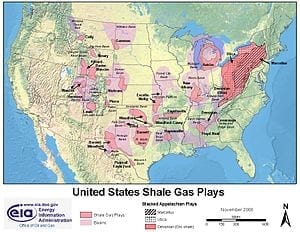
It is not going to result in long-term sustainable production or allow the U.S. to become a net oil exporter.
After 10 years of production, shale gas in the United States cannot be considered commercially viable, according to several scientists presenting at the Geological Society of America meeting in Denver on Monday. They argue that while the use of hydraulic fracturing and horizontal drilling for “tight oil” is an important contributor to U.S. energy supply, it is not going to result in long-term sustainable production or allow the U.S. to become a net oil exporter.
Charles A.S. Hall, professor emeritus at the College of Environmental Science and Forestry, State University of New York, Syracuse, is an expert on how much energy it takes to extract energy, and therefore which natural resources offer the best energy return on investment (EROI). He will describe two studies: one of the global patterns of fossil-fuel production in the past decade, and the other of oil production patterns from the Bakken Field (the giant expanse of oil-bearing shale rock underneath North Dakota and Montana that is being produced using hydraulic fracturing).
Both studies show that despite a tripling of prices and of expenditures for oil exploration and development, the production of nearly all countries has been stagnant at best and more commonly is declining — and that prices do not allow for any growth in most economies.
“The many trends of declining EROIs suggest that depletion and increased exploitation rates are trumping new technological developments,” Hall said.
J. David Hughes, president of the Canadian firm Global Sustainability Research Inc., echoes Hall with an analysis of the Bakken Field and the Eagle Ford Field of Texas, which together comprise more than half of U.S. tight oil production. It shows that drilling must continue at high levels, to overcome field decline rates of 40 percent per year.
Drilling rates of more than 3,000 wells annually in the Eagle Ford, and more than 1,800 wells annually in the Bakken, are sufficient to offset field decline and grow production — for now. If drilling at these high rates is maintained, production will continue to grow in both fields for a few more years until field decline balances new production. At that point drilling rates will have to increase as “sweet spots” (relatively small high-productivity portions of the total play area) are exhausted and drilling moves into lower-productivity regions, in order to further grow or even maintain production.
The onset of production decline will likely begin before the end of the decade, Hughes said.
“These sweet spots yield the high early production observed in these plays, but the steep decline rates inevitably take their toll. ”
Go deeper with Bing News on:
Shale oil and gas
- Marcellus Shale could supply 40% of US lithium — study
The National Energy Technology Laboratory says wastewater from oil and gas wells could help meet a growing demand for battery materials.
- The Truth Behind the Latest Oil Price-Fixing Scandal
The FTC has accused Scott Sheffield of colluding with OPEC. But this entire industry was built on price fixing in one form or another. Trying to make it competitive misses the point.
- Gas War: U.S. Oil Companies Accused of Price Fixing With OPEC, Increasing Inflation
Last week, the Federal Trade Commission (FTC) shared documents that would seem to suggest that U.S. shale oil firms purposefully colluded with the government of Saudi Arabia to fix oil prices between ...
- Can Utica Shale Really Compete With the Permian?
The Utica shale has for years been known as a gas-producing play. But this may be about to change as one company reports promising results from ...
- Big Oil finds more to love in deepwater exploration fields
As Big Oil returns this week to the industry's annual showcase for offshore energy projects and equipment in Houston, deepwater discoveries off Guyana, Namibia and the U.S. Gulf Coast will take the ...
Go deeper with Google Headlines on:
Shale oil and gas
[google_news title=”” keyword=”shale oil and gas” num_posts=”5″ blurb_length=”0″ show_thumb=”left”]
Go deeper with Bing News on:
Hydraulic fracturing and horizontal drilling
- The deal behind Colorado’s oil and gas deal: No new drilling policies until 2028
A grand bargain Gov. Jared Polis announced last week isn’t only intended to avert the current showdown over oil and gas development in Colorado. The political truce is engineered to prevent any ...
- Shale Gas Market, An Asset With Environmental Baggage As Market Valuation To Hit $137.53 Bn By 2031.
Shale gas, a natural gas trapped within rock formations, has revolutionized the global energy landscape. This unconventional resource boasts vast reserves, particularly in the United States, and its ...
- Unconventional Oil Play In Egypt Could Pay Off Big
Oil fields thought to be uneconomic were reawakened with a combination of horizontal drilling and hydraulic fracturing. One area of Texas, called the Eagle Ford Shale play, produced 271 million ...
- Natural Gas Hasn’t Been This Cheap in Decades
U.S. gas prices have been on a roller coaster in the two decades since energy producers began tapping shale formations using hydraulic fracturing and horizontal drilling techniques. Repeatedly ...
- ProPetro Holding Corp.
and Drilling. The Hydraulic Fracturing segment intends to optimize hydrocarbon flow paths during the completion phase of horizontal shale wellbores. The Cementing segment provides isolation ...
Go deeper with Google Headlines on:
Hydraulic fracturing and horizontal drilling
[google_news title=”” keyword=”hydraulic fracturing and horizontal drilling” num_posts=”5″ blurb_length=”0″ show_thumb=”left”]









